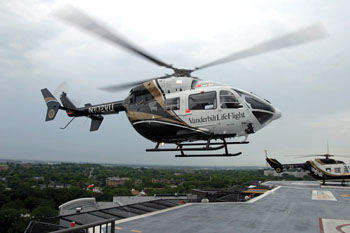
A new program aims to shorten the amount of time it takes to get heart patients to Vanderbilt from outlying communities. (photo by Dana Johnson)
New system set to speed transport of heart patients
When a person suffers a heart attack, every minute counts. The longer one waits before receiving treatment, the more heart muscle is lost and the greater the chance of permanent damage or death.
Timing is so critical that the American Heart Association in May launched Mission: Lifeline, a community-based initiative aimed at quickly activating the appropriate chain of events critical to opening a blocked artery that is causing a heart attack.
Vanderbilt Heart & Vascular Institute is taking that initiative one step further and empowering Emergency Room physicians in outlying areas to set in motion the process of transporting their patients to Vanderbilt and getting them into the cardiac cath lab as quickly as possible.
This initiative is referred to as the STEMI Network. STEMI is an acronym for ‘ST segment elevation myocardial infarction,’ which is basically a heart attack caused by a blocked coronary artery. The gold standard for treating a STEMI is to open up the artery via balloon angioplasty and insert a stent. The procedure is performed in the cath lab and is highly effective — if it is done in time.
The period of time from when a patient enters an Emergency Room until the artery is opened is referred to as door-to-balloon time. The goal of the STEMI Network is a 90-minute door-to-balloon time for patients within a 60-mile radius who are first seen in their local ER; 100 minutes or less if they are within 60-75 miles; and 120 minutes if they are within 75 -125 miles.
The national average time for transferring a patient for intervention for a heart attack is 180 minutes if he is within 60 miles, said Joseph Fredi, M.D., assistant professor of Medicine.
“A large percentage of our patients don't walk through our doors; they go to their local ER. The question becomes, can we organize a network or system where we can expedite the care of these patients so they get the same sort of care given to people who live here, even though they are geographically at a distance away from us?” Fredi asked.
Typically, when a person with heart attack symptoms walks into an ER in a small community, he or she will undergo a 12-lead EKG. A STEMI is easily recognizable on an EKG. Oftentimes, the ER physician will call the patient's cardiologist, who will refer the patient to Vanderbilt. A Vanderbilt cardiologist reviews the EKG, which has been faxed, accepts the patient and notifies LifeFlight to transport the patient, who is then brought to Vanderbilt’s ER before going to the cath lab.
Meanwhile, the clock is ticking.
The new STEMI Network approach will enable the ER physician in the community hospital to directly contact LifeFlight and activate the Vanderbilt cath lab with a single call. Once the patient arrives here, he goes immediately to the cath lab.
“We want the referring ER doctor to pick up the phone and say they have an acute MI and, with one phone call, immediately dispatch transportation, secure a bed here at Vanderbilt, call in the interventional cardiologist who is going to do the procedure, and call in all the cath lab staff,” Fredi said. “Rather than making multiple phone calls and waiting for phone calls back, one phone call will achieve all of this.”
A cardiac cath team from Vanderbilt tested the STEMI Network last week in a drill that involved an ER in a Kentucky community. The drill went well, according to STEMI coordinator Carol Scott, A.P.R.N.
“We feel that the drill was a success, and it showed us that the hard work we've put into establishing this network is going to benefit our patients in outlying areas,” she said.
Fredi and Scott have been traveling to community hospitals, meeting with ER physicians, nurses and hospital CEOs to share information about the STEMI Network and to forge partnerships in the name of saving lives. Fredi and Scott said they hope to have four to six ER partners by the end of the year and add six to 10 per year after that.
“We're empowering the local emergency rooms and their physicians to go ahead and activate the network. That's saving minutes. All of these minutes are important to get that vessel open expeditiously and save heart function. That's the goal,” Fredi said.













